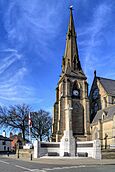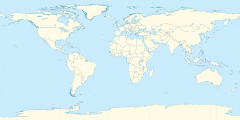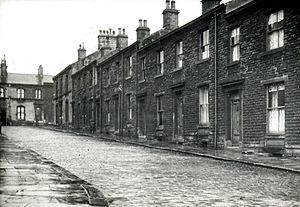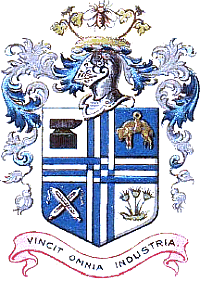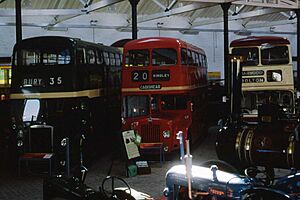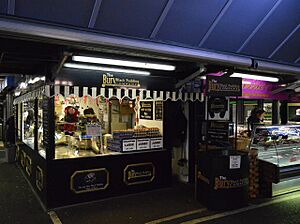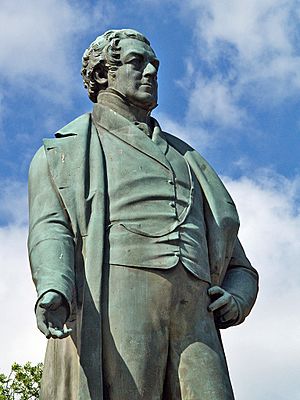Bury, Greater Manchester facts for kids
Quick facts for kids Bury |
|
|---|---|
| Town | |
|
The market place, The Rock, Whitehead Clock Tower, St Mary the Virgin Church, the town hall and the market |
|
| Area | 11.61 sq mi (30.1 km2) |
| Population | 81,101 (2021 Census) |
| • Density | 6,985/sq mi (2,697/km2) |
| OS grid reference | SD805105 |
| • London | 169 mi (272 km) |
| Metropolitan borough | |
| Shire county |
|
| Region | |
| Country | England |
| Sovereign state | United Kingdom |
| Post town | BURY |
| Postcode district | BL0, BL8, BL9 |
| Dialling code | 0161 |
| Ambulance | North West |
| EU Parliament | North West England |
| UK Parliament |
|
Bury (pronounced like berry or burry) is a busy market town located on the River Irwell in Greater Manchester, England. In 2021, about 81,101 people lived in the town. The wider area, called the Metropolitan Borough of Bury, had a population of 193,846.
Bury was once part of Lancashire. It became part of Greater Manchester in 1974. During the Industrial Revolution, Bury grew into a big mill town. It was famous for making textiles, especially cotton. Today, Bury is well-known for its outdoor Bury Market and for a traditional local food called black pudding.
A very important person, Sir Robert Peel, was born in Bury. He was a Prime Minister of the United Kingdom who started the Metropolitan Police (the police force in London). He also helped create the Conservative Party. You can find a memorial to him outside Bury Parish Church and a monument on Holcombe Hill. Bury is about 5 miles (8 km) east of Bolton and 8 miles (13 km) north-west of Manchester.
Bury's History
What's in a Name?
The name Bury has been around for a long time. It used to be called Buri or Byri. This name comes from an old English word that means castle, stronghold, or fort. It's similar to the modern English word borough.
Early Days
Bury grew up around an old market place. But people lived here even earlier, during the time of Roman occupation. The Bury Museum has a Roman pot with old bronze coins from AD 253–282. These coins were found north of the town centre. The Romans also built a road from their fort in Manchester (Mamucium) to another fort at Ribchester (Bremetennacum). This road went through nearby Radcliffe. Part of a modern road, Watling Street, still follows this old Roman path.
The most impressive building in early Bury was Bury Castle. It was a medieval manor house built in 1469 for Sir Thomas Pilkington. The castle was built on high ground, which was a good spot for defense, overlooking the Irwell Valley. The Pilkington family supported the House of York during the Wars of the Roses. When Richard III was defeated in 1485, Thomas Pilkington was captured and later executed. The land was then given to the Stanley family, who became the Earls of Derby.
The Earls of Derby still have connections to Bury. For example, Derby High School is named after them. The Bury Grammar School also has a house named Derby because the 15th and 16th Earls supported the school.
The old castle remains were hidden under the streets near the Castle Armoury. They were finally dug up and studied in the 1970s.
Between 1801 and 1830, Bury's population more than doubled. This was when factories, mines, and foundries with their spinning machines and steam engines started to appear everywhere.
The Industrial Revolution
In the 17th and 18th centuries, people in Bury made textiles at home, mostly wool. They used water-powered mills to process the wool.
Things changed quickly in the late 1700s and early 1800s. In 1773, Sir Robert Peel's family started Brooksbottom Mill in Summerseat. This was a calico printing factory and marked the start of the cotton industry in Bury. By the early 1800s, cotton was the main textile made here. The Rivers Roch and Irwell provided power for the mills.
Bury grew even more when it was connected to the national canal system by the Manchester, Bolton & Bury Canal in 1808. The canal got its water from Elton Reservoir. Another mill built by the Peel family in 1790 was at the Burrs, and you can still see its remains today. By 1818, Bury had seven cotton mills. The town's population grew from 9,152 in 1801 to 58,029 in 1901.
Later, railways were built, connecting Bury to Manchester, Rawtenstall, and Accrington. There were also connections to nearby mill towns like Bolton, Heywood, and Rochdale. Besides cotton mills, other industries like paper-making and engineering also grew. The town expanded, and rows of terraced houses were built around the town centre. Areas like Freetown, Fishpool, and Pimhole changed from farmland to streets of houses next to factories.
Many of these early houses were very basic, without proper facilities or sewers. This led to the quick spread of diseases. Social reformers like Edwin Chadwick were worried about these problems. Even though Bury didn't have many of the huge spinning mills seen in other Lancashire towns later on, some mills, known as Peel Mills, are still used today. Their name reminds us of the Peel family's link to the town.
The Lancashire Fusiliers
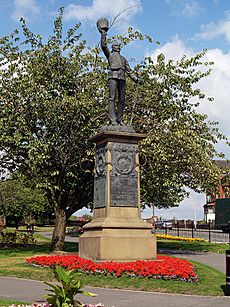
Bury is famous for being the home of the Lancashire Fusiliers, a well-known army regiment. In 1688, a regiment was formed in the Exeter area. Later, in 1881, a special army base called Wellington Barracks was set up in Bury for this regiment.
The barracks were built partly because of the Chartist movement. This was a large group of working-class men who wanted to make the political system fairer. They asked for things like:
- Every man over 21 should be able to vote.
- Voting should be secret.
- People shouldn't need to own property to become a Member of Parliament.
- MPs should be paid so that ordinary working people could afford to be in Parliament.
- All voting areas should have the same number of voters.
- Parliamentary elections should happen every year.
The Chartists believed they were fighting for democracy and against corruption in industrial society.
Modern Bury
After World War II, the cotton industry in Bury declined. Many factory chimneys were pulled down, and mills closed. In the late 1960s, the old shopping area was replaced by a concrete shopping centre. This was then replaced by the Mill Gate Shopping Centre in 1995.
In 2010, a big new shopping area called The Rock opened. It has many independent shops and places to eat. There's also a cinema, a bowling alley, and big department stores like Marks & Spencer and Primark.
Bury is still famous for its traditional market, known for its "world famous" black pudding. Bury Market attracts thousands of visitors every year. The town has also become a popular place for people who work in nearby Manchester to live. Many new houses have been built in areas like Unsworth and Redvales.
The old railway line to Manchester Victoria closed in 1990. It was replaced by the Metrolink tram system in 1992. Bury also got a motorway connection, the M66, in 1978.
How Bury is Governed
Bury started as a parish and then had local groups that helped manage the town. In 1876, Bury became a borough. In 1889, it became a county borough of Lancashire.
Bury's coat of arms was given in 1877. Its symbols show the town's industries:
- An anvil for metalworking.
- A golden fleece for the wool industry.
- Crossed shuttles for the cotton industry.
- A papyrus plant for paper-making.
The Latin motto "Vincit Omnia Industria" means "work conquers all".
In 1974, the Local Government Act 1972 changed things. Bury joined with nearby towns like Radcliffe and Prestwich to form the Metropolitan Borough of Bury. This borough is part of Greater Manchester.
In 2008, people in Bury voted on whether they should have a directly elected mayor. They decided not to have one.
Bury's Location and Climate
| Weather chart for Bury | |||||||||||||||||||||||||||||||||||||||||||||||
|---|---|---|---|---|---|---|---|---|---|---|---|---|---|---|---|---|---|---|---|---|---|---|---|---|---|---|---|---|---|---|---|---|---|---|---|---|---|---|---|---|---|---|---|---|---|---|---|
| J | F | M | A | M | J | J | A | S | O | N | D | ||||||||||||||||||||||||||||||||||||
|
70
8
2
|
70
8
2
|
50
10
3
|
63
13
5
|
51
16
8
|
58
19
10
|
54
21
12
|
68
21
12
|
63
18
10
|
88
14
8
|
82
10
4
|
78
7
2
|
||||||||||||||||||||||||||||||||||||
| temperatures in °C precipitation totals in mm |
|||||||||||||||||||||||||||||||||||||||||||||||
|
Imperial conversion
|
|||||||||||||||||||||||||||||||||||||||||||||||
Bury is located near the Pennines mountains in North West England. Its position on the River Irwell has been very important throughout its history. The river flows from north to south, dividing the town. The town centre is on the east side of the river. Bury Bridge is a key crossing point, connecting the town centre to the western parts of Bury and to Bolton.
Bury has a mild climate with warm summers and cool winters. The nearby Western Pennine Moors help to protect it. Summers are usually dry with low rainfall. Temperatures rarely go above 30°C (86°F). Winters are cool, and temperatures can drop below freezing between December and March. Extreme weather is not common in Bury.
Population of Bury
In 2001, the town of Bury had a population of 77,211 people. The whole Metropolitan Borough of Bury had 183,200 people.
Cool Places to See in Bury
Bury has many interesting places to visit:
- Bury Art Museum: This museum has a great collection of paintings, including works by famous artists like J. M. W. Turner and John Constable. The building itself is also very beautiful.
- Bury Castle: This was a fortified manor house built in the 13th century. You can visit the excavated foundations, which opened to the public in 2000.
- Bury Parish Church: Located in the town centre, this church is a very important historic building.
- Bury's 'World-Famous' Market: This market has been running for almost 600 years! It was voted the best 'British Market of the Year' in 2006 and the 'Market of the Year' by BBC Radio 4 in 2008. Many visitors come by coach every year.
- Peel Tower: This tower is on Harcles Hill, overlooking the town. It was built to remember Sir Robert Peel, who was born in Bury. Many people climb to the tower on Good Friday each year.
- Whitehead Clock Tower: This clock tower is in Whitehead Garden, near the Town Hall. It was built in 1913 to remember Walter Whitehead, a famous surgeon from Bury.
- East Lancashire Railway: This is a special heritage railway. You can take a ride on old trains from Bury to Heywood, Ramsbottom, and Rawtenstall. The main station is Bury Bolton Street railway station.
- Fusilier Museum: This museum tells the story of the Lancashire Fusiliers army regiment. It's located on Moss Street.
Bury also has some great sculptures and public art. You can see a statue of Sir Robert Peel in the town centre. There's also the Lancashire Fusiliers War Memorial and a statue of a "cheering fusilier" in Whitehead Garden. The Kay Monument remembers John Kay, who invented the flying shuttle, a key invention in the textile industry.
Getting Around Bury
Bury has good transport links, including bus services, the Metrolink tram system, and the heritage railway.
From 1903 to 1949, Bury had its own tram network.
Bury Bolton Street railway station opened in 1846. It's now home to the East Lancashire Railway, which offers heritage train rides. This station was once a main railway station until 1980.
Bury used to have two main railway stations. Bury Knowsley Street railway station closed in 1970. In 1980, Bury Interchange opened. It combined a railway station and a bus station. In 1992, the Metrolink tram system took over the railway line. This means Bury no longer has a direct connection to the national heavy rail network.
Today, most buses in Bury are run by the Bee Network, Go North West, and Rosso. They connect Bury to other places in Greater Manchester and beyond. The bus station is connected to the Metrolink tram stop, making it easy to switch between buses and trams. There's also a free car park and a place to park bikes. The station is in the town centre, close to Bury Market and shopping areas.
Manchester Metrolink trams run from Bury to Altrincham and Piccadilly. Trams usually run every 6 minutes to Manchester city centre.
Learning in Bury
Bury has several colleges and high schools:
- Colleges
- Bury College: This college was formed by combining Bury Technical College, Peel Sixth Form College, and Stand Sixth Form College.
- Bury Grammar School: This school has been around since 1570.
- Bury Grammar School (Girls): This school for girls opened in 1884.
- Holy Cross College: This college was once Bury Convent Grammar School. In 2008, it was named the second best college in the country for student performance.
- High schools in Bury include
- Broad Oak High School
- Bury Church of England High School
- Bury Grammar School (Independent)
- Bury Grammar School (Girls) (Independent)
- Derby High School
- Elton High School
- St Gabriel's RC High School
- Tottington High School
- Woodhey High School
Sports in Bury
Bury F.C. is the town's local football club. They play in the North West Counties Premier Division. In August 2019, the club faced problems and was removed from the Football League.
The Lancashire Spinners are a basketball team based in Bury. They play in the second-tier English Basketball League Division 1.
Bury Broncos are a Rugby League team from the Prestwich area. They were formed in 2008.
Bury's Culture
Performing Arts
The Met arts centre is a small venue in the Derby Hall. It hosts theatre, music, and comedy shows. Famous comedians like Peter Kay and Jason Manford performed there before they became well-known.
Museums and Galleries
Bury Art Museum has a great collection of art from the Victorian period and the 20th century.
The Fusilier Museum tells the story of the Lancashire Fusiliers regiment, covering over 300 years of their history.
The Bury Transport Museum is part of the East Lancashire Railway. It has a collection of old vehicles and fun, interactive displays. It's located in the restored Castlecroft Goods Shed, which is a historic building from 1848.
Music Scene
The band Elbow, who won the Mercury Music Prize in 2008, is from Bury. Their lead singer is Guy Garvey. In 2009, the band was given the Freedom of the Borough because of their success.
Bury also hosts several music festivals each year:
- Glaston-Bury Festival: Held on the August bank holiday weekend, it features local and upcoming bands.
- Head for the Hills Festival: This festival (formerly Ramsbottom Festival) happens in mid-September. It features a wider range of artists, including famous bands like Soul II Soul. The festival also has a popular silent disco.
Food Delights
Bury is very famous for its black puddings. You'll often see them called "Bury Black Pudding" on menus. Bury also has its own version of simnel cake, called Bury simnel cake.
Media in Bury
Television
Local news and TV shows for Bury are provided by BBC North West and ITV Granada.
Radio
Bury is served by several local radio stations:
- BBC Radio Manchester
- Heart North West
- Smooth North West
- Greatest Hits Radio Bolton & Bury
- XS Manchester
- Capital Manchester and Lancashire
- Rochdale Valley (a community radio station from Rochdale)
Newspapers
The Bury Times is the local newspaper. You can also read regional newspapers like the Manchester Evening News.
Famous People from Bury
Many notable people have come from Bury:
- Sir Robert Peel (1788–1850): A 19th-century Prime Minister of the United Kingdom. He is famous for starting the modern police force (which is why police officers are sometimes called "Bobbies" or "Peelers"). A monument called Peel Tower stands in his memory. A statue of Peel is in Market Place.
- John Kay (1704 – c. 1779): He invented the flying shuttle, a very important invention during the Industrial Revolution that changed weaving. A memorial to him is in Kay Gardens in Bury.
- James Wood (1760–1839): A mathematician and Master of St John's College, Cambridge. He was born in Holcombe, Bury.
- Professor Sir John Charnley (1911–1982): Born in Bury, he was a famous surgeon who developed hip replacement surgery in 1962. He was knighted for his work.
- Andrew Higginson: A businessman and chairman of Wm Morrison Supermarkets Plc.
- Cherie Blair: A barrister and the wife of former Prime Minister Tony Blair.
Sports Stars
- Nicky Ajose: Former footballer.
- Andy Goram: Scottish international footballer.
- James Guy: Olympic gold medal swimmer.
- Gary Neville: Former Manchester United F.C. captain.
- Phil Neville: Former Manchester United and Everton F.C. player, and Gary's younger brother.
- Tracey Neville: Netball international and sister of Gary and Phil Neville.
- Scott Quigg: A boxing champion.
- Lawrie Smith: A yachtsman who won a bronze medal at the 1992 Barcelona Olympics.
- Kieran Trippier: Footballer for Newcastle United and England.
- Adam Yates and Simon Yates: Twin brothers who are professional cyclists.
Writers
- Richmal Crompton: Author, born in Bury. Her father taught at Bury Grammar School.
- Thomas Thompson (1880–1951): Author and broadcaster, born and lived in Bury.
Actors and Entertainers

- Gemma Atkinson: Actress and model.
- Antony Cotton: Actor, known as Sean Tully in Coronation Street.
- Helen Flanagan: Actress, known as Rosie Webster in Coronation Street.
- Ralf Little: Actor, known for The Royle Family.
- Jennie McAlpine: Actress, known as Fiz in Coronation Street.
- Christian McKay: Actor, known for playing Orson Welles in a film.
- Lisa Riley: Actress and TV presenter, known as Mandy Dingle in Emmerdale.
- Suzanne Shaw: Singer and actress, famous from the group Hear'say.
- Charley Webb: Actress, known as Debbie Dingle in Emmerdale.
- Layton Williams: Actor, known for Bad Education and West End theatre.
- Victoria Wood: Comedian, composer, and actor. A statue of her stands opposite Bury's central library.
Musicians
- Guy Garvey: Lead singer of the band Elbow.
- John Howard: Singer-songwriter.
- Christian Savill: Guitarist with Slowdive.
- Peter Skellern: Singer-songwriter and pianist.
- Ian Wallace: Rock drummer who played with King Crimson and Bob Dylan.
- David Whittaker: Video game composer.
Members of Parliament
- Sir David Trippier (born 1945): Former MP.
- David Crausby (born 1946): MP for Bolton North East, born in Bury.
- David Chaytor (born 1949): Former MP for Bury North, born in Bury.
- Alistair Burt (born 1955): Former MP, born in Bury and was School Captain of Bury Grammar School.
Bury's Twin Towns
The Metropolitan Borough of Bury is twinned with five towns in different countries: China, France, Germany, and the United States. This means they have special friendly relationships and often share cultural exchanges.
| Country | Place | County / District / Region / State | Originally twinned with | Date | Notes | |||
|---|---|---|---|---|---|---|---|---|
| China | Datong | Shanxi | Metropolitan Borough of Bury | 2003 | ||||
| France | Angoulême | Poitou-Charentes | County Borough of Bury | 1959 | After which the 'Angoulême Retail Park' and the road 'Angoulême Way' are named. | |||
| France | Tulle | Limousin | Municipal Borough of Prestwich | 1969 | ||||
| Germany | Schorndorf | Baden-Württemberg | Metropolitan Borough of Bury | 1994 | ||||
| United States | Woodbury | New Jersey | Metropolitan Borough of Bury | 2000 |
Images for kids
See also
 In Spanish: Bury (Gran Mánchester) para niños
In Spanish: Bury (Gran Mánchester) para niños





